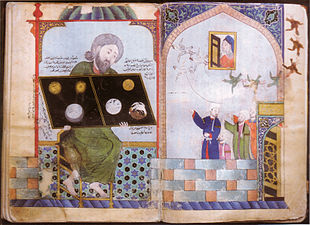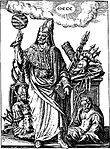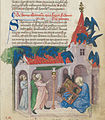Ibn Umayl

Muḥammad ibn Umayl al-Tamīmī(Arabic:محمد بن أميل التميمي), known inLatinasSenior Zadith,was an early Muslimalchemistwho lived fromc. 900toc. 960 AD.
Very little is known about his life.[2] AVatican Librarycatalogue lists one manuscript with thenisbaal-Andalusī,[3]suggesting a connection toIslamic Spain,but his writings suggest he mostly lived and worked inEgypt. He also visited North Africa and Iraq.[4][5]He seems to have led an introverted life style, which he recommended to others in his writings.[6][7]Statements in his writings, comparing the Alchemical oven with Egyptian temples suggest that he might have lived for some time inAkhmim,the former centre of Alchemy. He also quoted alchemists that had lived in Egypt:Zosimos of PanopolisandDhul-Nun al-Misri.[7]: XIV
In later European literature, ibn Umayl became known by a number of names: his titleSheikhbecome 'senior' by translation into Latin, thehonorifical-sadikrendered phonetically as 'Zadith'[8]and 'ibn Umail' becoming by erroneous translation 'filius Hamuel', 'ben Hamuel' or 'Hamuelis'.
Historical value[edit]
| Part ofa serieson |
| Hermeticism |
|---|
 |
TheSilvery Waterwas particularly valuable toStapleton,[5]Lewis, andSherwood Taylor,who showed that of some of Umail'sSayings of Hermescame from Greek originals. Also its numerous quotations from earlier alchemical authors[2]: 102 allowed, for example, Stapleton to provenance theTurba Philosophorumas being Arabic in origin,[2]: 83 and Plessner to date theTurba Philosophorumto ca. 900 AD.[9]
Ibn Umayl's works contain an early commentary on theEmerald Tablet(a short and compact text attributed toHermes Trismegistus), as well as a number of otherHermeticfragments.[10]
Symbolic alchemist[edit]
Ibn Umayl was amysticalandsymbolicalchemist. He saw himself as following his “predecessors among the sages of Islam” in rejecting alchemists who take their subject literally. Although such experimenters discovered the sciences of metallurgy and chemistry, Ibn Umayl felt the symbolic meaning of alchemy is the precious goal that is tragically overlooked. He wrote:
“Eggs are only used as an analogy... the philosophers… wrote many books on such things as eggs, hair, the biles, milk, semen, claws, salt, sulphur, iron, copper, silver, mercury, gold and all the various animals and plants… But then people would copy and circulate these books according to the apparent meaning of these things, and waste their possessions and ruin their souls”The Pure Pearlchap. 1.[4]
Moreover, he wrote aBook of the Explanation of the Symbols,there emphasizing that the sages spoke "a language in symbols" and that they "would not reveal it [the secret of the stone] except with symbols".[11]In this book, he gives a huge list of names for the stone, the water, etc. thus referring to one inner mystery or religious experience, which - in contrast to an allegory - cannot be fully explained.[12][13]
For all his devotion toGreek alchemy,Ibn Umayl wrote as aMuslim,frequently mentioning his religion, explaining his ideas "for all our brothers who are pious Muslims" and quoting verses from theQuran.[4]
The interpreter[edit]
Ibn Umail presented himself as an interpreter of mysterious symbols. He set his treatiseSilvery Waterin an Egyptian templeSidr wa-Abu Sîr,the Prison of Yasuf, where Joseph learned how to interpret thedreams of the Pharaoh.(Koran: 12 Yusuf and Genesis: 4)
"... none of those people who are famous for their wisdom could explain a word of what the philosophers said. In their books they only continue using the same terms that we find in the sages.... What is necessary, if I am a sage to whom secrets have been revealed, and if I have learned the symbolic meanings, is that I explain the mysteries of the sages."[5]
Ibn UmailsBook of the Explanation of Symbols (Ḥall ar-Rumūz)can be considered as a summary of hisSilvery Water and Starry Earth,giving a "unified synthesis of Ibn Umail's earlier works".[7]: XVI
Modern psychological interpretations[edit]
The psychologistCG Jungrecognized in ibn Umayl's story the ability to bringself-realizationto a soul by interpreting dreams, and from the 1940s onwards focused hiswork on alchemy.In continuation of Jung's approach towards alchemy, the psychologist Theodor Abt states that Ibn Umail'sBook of the Silvery Water and the Starry Earthgives a description of a process of distillation, which is meant as image for a process of "continuous pondering over the different symbols", creating thus consciousness (symbolised by 'light', 'gold') out of the reality of matter, nature and body ('starry earth'). This shows that the "alchemical process is in fact entirely a psychological work that is based on dealing with concrete matter and the bodily reality."[5]: 96.21–26 [7]: XVI
Works Attributed to ibn Umail[edit]
- Ḥall ar-Rumūz(Solving the Riddles/Book of Explanation of the Symbols)[7]
- ad-Durra an-Naqīya(The Pure Pearl)
- Kitāb al-Maghnisīya(The Book of Magnesia)
- Kitāb Mafātīḥ al-Ḥikma al-‘Uẓmā(The Book of the Keys of the Greatest Wisdom)
- al-Mā’ al-Waraqî wa'l-Arḍ an-Najmīya(The Silvery Water and the Starry Earth) that comprises a narrative; a poemRisālat ash-Shams ilā al-Hilâl(Epistola solis ad lunam crescentem, the letter of the Sun to the Crescent Moon),[14][15]
- Al-Qasida Nuniya(Poem rhyming on the Letter Nun), with a commentary by Ibn Umail. Ms. Beşir Ağa (Istanbul) 505. For the poem without commentary see Stapelton'sThree Arabic Treatises[5]
- Al-Qasida al-mīmīya(Poem rhyming on the Letter Mīm), with a commentary by Ibn Umail[16]
Later publications[edit]
- 12th century:al-Mā’ al-Waraqī(Silvery Water) became a classic of Islamic Alchemy. It was translated into Latin in the twelfth or thirteenth century and was widely disseminated among alchemists in Europe often calledSenioris Zadith tabula chymica(The Chemical Tables of Senior Zadith)[14]
- 1339: In theal-Mâ’ al-Waraqītranscript that is now in Topkapi Palace Library, Istanbul, the scribe added a note to the diagram that the sun represents the spirit (al-rūḥ) and the moon the soul (al-nafs) so the "Letter from the Sun to the Moon" is about perfecting the receptivity of soul to spirit.[14]
- 14th century:Chaucer'sCanon's Yeoman's Talehas alchemy as a theme and citesChimica Senioris Zadith Tabula(The Chemical Tables of Senior Zadith). Chaucer considered Ibn Umayl to be a follower ofPlato.
- 15th century:Aurora consurgensis a commentary by Pseudo Aquinas on a Latin translation ofAl-mâ' al-waraqî(Silvery Water).
- 1605Senioris Zadith filii Hamuelis tabula chymica(The Chemical Tables of Senior Zadith son of Hamuel) was printed as part I ofPhilosophiae Chymicae IV. Vetvstissima Scriptaby Joannes Saur[17]
- 1660: The Chemical Tables of Senior Zadith retitledSenioris antiquissimi philosophi libelluswas printed in volume 5 of theTheatrum chemicum.
- 1933Three Arabic treatises on alchemy by Muhammad bin Umail (10th century AD),prints the three treatises in Arabic, and prints them in 13th century Latin as they were partially translated from the Arabic to Latin in 13th century. Printed in the journalMemoirs of the Asiatic Society of Bengal,Volume 12, Calcutta.[5]
- 1997/2006: Corpus Alchemicum Arabicum 1A: An improved translation ofBook of the Explanation of the Symbols. Kitāb Ḥall ar-Rumūzwith a commentary by theJungianpsychologistand scholarMarie-Louise von Franz.[12]
Gallery[edit]
-
Ibn Umayl was depicted in later European books. InAurora consurgens,c.1400, Here Senior Zadith carries the Key that opens The Treasure House of Wisdom.
-
Aurora Consurgens also illustrates the statue of an ancient sage holding the tablet of wisdom described in Ibn Umayl'sThe Silvery Water
References[edit]
- ^Abt, Theodor (2009).Book of the Explanation of the Symbols. Kitāb Hal ar-Rumūz. Psychological commentary by Theodor.Corpus Alchemicum Arabicum (CALA) IB. Zurich: Living Human Heritage Publications.ISBN978-3952260883.
- ^abcHolmyard, E.J. (1990) [1957].Alchemy(reprint ed.). New York: Dover.ISBN0486262987.
- ^Paul Kraus: Jâbir ibn Haiyân, Cairo, IFAO, 1942–3, p. 299.
- ^abcStarr, Peter:Towards a Context for Ibn Umayl, Known to Chaucer as the Alchemist Senior.Retrieved 2024-05-06
- ^abcdefTurāb ʿAlī, M.;Stapleton, H. E.;Hidāyat Ḥusain, M. (1933)."Three Arabic Treatises on Alchemy by Muḥammad bin Umail (10th century A.D.)".Memoirs of the Asiatic Society of Bengal.12(1): 1–213.OCLC29062383.This seminal work was reprinted in facsimile in 2002 asIbn Umayl (fl. c. 912). Texts and Studies(Collection"Natural Science in Islam"Archived2011-05-27 at theWayback Machine,vols. nº 55-75). Ed. F. Sezgin.ISBN3-8298-7081-7.Published byInstitut für Geschichte der Arabisch-Islamischen WissenschaftenArchived2011-05-27 at theWayback Machine,University of Frankfurt, Westendstrasse 89, D-60325 Frankfurt am Main.
- ^Ibn Umayl, Mohammad.Ad-Durra an-naqīya Ms No. 1410.Hyderabad: Asaf. lib.fol. 2f.
- ^abcdeAbt, Theodor; Madelung, Wilferd; Hofmeier, Thomas (2003).Book of the Explanation of the Symbols. Kitāb Ḥall ar-Rumūz by Muḥammad ibn Umail.Corpus Alchemicum Arabicum (CALA) I. Translated by Salwa Fuad and Theodor Abt. Zurich: Living Human Heritage Publications.p. XIII.
- ^Julius Ruska,Senior Zadith = Ibn Umail.Orientalistische Literaturzeitung 31, 1928, pp. 665-666.
- ^Martin Plessner,The Place of the Turba Philosophorum in the Development of Alchemy.ISIS, Vol. 45, No. 4, Dec. 1954, pp. 331-338
- ^Stapleton, H. E.;Lewis, G. L.;Taylor, F. Sherwood(1949). "The sayings of Hermes quoted in the Māʾ al-waraqī of Ibn Umail".Ambix.3(3–4): 69–90.doi:10.1179/amb.1949.3.3-4.69.p. 81,et passim.
- ^Mohammed ibn Umail:Book of the Explanation of the Symbols - Kitab Hall ar-Rumuz,edited by Th. Abt and W. Madelung, Corpus Alchemicum Arabicum (CALA) 1, Zurich 2003, p. 3.8; see also: p. 5.20 ( "symbols of sages" ), p. 145.2 ( "reveal it except with symbols" ), p. 151.3 ( "dog as symbol" ).
- ^abvon Franz, Marie-Louise (2006). Theodor Abt (ed.).Book of the Explanation of the Symbols. Kitāb Ḥall ar-Rumūz by Muḥammad ibn Umail. Psychological commentary by Marie-Louise von Franz.Corpus Alchemicum Arabicum (CALA) IA. Zurich: Living Human Heritage Publications. pp. 11, 15, 26–7.ISBN3952260835.
- ^An allegory can be replaced by one word or one phrase and thus be sufficiently explained. See about this discrimination: Theodor Abt,Psychological Commentary on Ibn Umails "Book of the Explanation of the Symbols - Kitab Hall ar-Rumuz",Corpus Alchemicum Arabicum (CALA 1B), Zurich 2009, p. 67-71.
- ^abcBerlekamp, Persis (2003).Murqarnas Volume 20: Painting as Persuasion, a visual defense of alchemy in an Islamic manuscript of the Mongol period.Leiden, Netherlands: Koninklijke Brill NV.ISBN9004132074.
- ^Julius Ruska,Studien zu Muhammad Ibn Umail al-Tamimi's Kitab al-Ma' al-Waraqi wa'l-Ard an-Najmiyah,Isis, Vol. 24, No. 2 (Feb., 1936), pp. 310-342.
- ^Ms. Beşir Ağa (Istanbul) 505.
- ^Dickinson College Digital CollectionsPhilosophiae Chymicae IV. Vetvstissima Scripta
External links[edit]
- Chaucer Name Dictionary1988, Jacqueline de Weever, Garland Publishing
- (in French)Commentary on theBibliotheca Chemicaat item 86.
- Millesima, Julia (2011)."ibn Umail-Senior Zadith, Introduction to Tabula Chimica".Alchemy Key Concepts & the Art of Fire. Ancient Authors & Hidden Evidence.Labyrinth Designers.Retrieved29 August2013.
- In Arabic."Three Arabic treatises on alchemy by Muhammad bin Umail (10th century AD): EDITION OF THE TEXTS",published inMemoirs of the Asiatic Society of BengalVolume 12, year 1933.


